Why AI-Powered ATS is a Game-Changer for Remote Hiring

Remote hiring is now common, but it has challenges. You may feel stressed by too many applications or unsure about fair evaluations. This is where AI helps improve your hiring process. It automates boring tasks and studies data, letting you focus on finding the best person for the job.
Think about this: 79% of recruiters say they hire better people with an ATS. Also, 86% say it makes hiring faster. Using the Best ATS for Remote Hiring, you can make hiring easier, choose better, and give candidates a smooth experience. Why use old ways when AI can make hiring better?
Challenges in the Remote Hiring Process

Lack of In-Person Interaction
Hard to judge soft skills and cultural fit.
Remote hiring makes it tough to understand a candidate’s personality. Without meeting in person, you can’t see body language or behavior. These small details help show how someone works with others. Soft skills are important for teamwork and keeping a good workplace vibe.
Few chances for real-time communication.
Remote interviews often use video calls or emails. This limits natural conversations. Without real-time chats, it’s harder to see a candidate’s true abilities. Misunderstandings can happen, especially when reading non-verbal signals or excitement levels.
Managing High Application Volumes
More applicants due to remote work options.
Remote work has made the talent pool much bigger.
95% of workers now like some remote work.
60% of job seekers want remote jobs.
By August 2024, 22.8% of U.S. workers did part-time remote work, over 35 million people.
This gives access to more talent but also means more resumes to check. It can make hiring feel overwhelming.
Manual resume reviews take too long.
Going through hundreds of resumes by hand is slow and tiring. It delays hiring and risks missing great candidates. Slow responses upset applicants, and 69% won’t accept offers from slow companies.
Bias and Inconsistencies in Hiring
Hard to ensure fair and equal evaluations.
Remote hiring can bring new biases. For example, candidates may be judged on voice tone or confidence. Studies show 39% of rejections come from things like no eye contact or smiling. These biases can lead to unfair decisions and missed talent.
Uneven decisions among remote hiring teams.
Remote teams may not agree on how to judge candidates. Different team members might see qualifications differently, causing unfair results. Tools like AI can help fix this. For example, one global eCommerce company improved fairness by 68% using structured evaluations.
How AI-Enhanced Applicant Tracking Systems Solve Remote Hiring Challenges

Automation of Administrative Tasks
Making resume screening and shortlisting easier.
Looking through many resumes can be tiring and slow. AI-powered tracking systems handle this for you. They quickly scan resumes to find the best matches for the job. This saves time and ensures no good candidate is missed. Big companies like Ernst & Young use AI to match people to jobs better and faster.
Simplifying interview scheduling and follow-ups.
Setting up interviews can be tricky, especially for remote jobs. AI tools make it simple by letting candidates choose their own time slots. Automated reminders help reduce missed interviews, saving effort. These tools also make candidates feel important with quick updates and personal messages. Unilever saw a 40% boost in candidate interest after using AI in hiring.
Smarter Candidate Matching
Using AI to find the right candidates.
AI tools study candidate profiles to match them with jobs. They don’t just look at keywords but also check skills, experience, and personality fit. This helps you find the best person for the job faster and more accurately.
Avoiding unfair decisions in hiring.
People can sometimes make biased choices without meaning to. AI tools give fair and equal evaluations to all candidates. This leads to more diverse and fair hiring. With AI, you can trust the process to be fair and consistent.
Data-Driven Insights for Better Decisions
Helping improve hiring plans with data.
AI tools don’t just help hire; they also give useful tips. They show what works best, like which job ads attract top talent or where delays happen.
Spotting patterns in remote hiring.
AI looks at past hiring data to find trends. This helps you plan better for future needs. Knowing these patterns keeps you ahead in the remote job market.
Enhancing the Candidate Experience
Personalized communication and updates
It’s annoying to apply for jobs and hear nothing back. AI-powered ATS fixes this by keeping candidates updated. It sends custom messages so applicants feel important and involved. Big companies like Unilever and Ernst & Young improved satisfaction using AI for better communication.
AI tools send messages based on where candidates are in the process. Whether it’s a confirmation or interview feedback, these updates leave a good impression. This personal touch makes candidates happy and improves your company’s image. A LinkedIn study showed 91% of recruiters using AI saw better engagement and higher retention rates.
Faster response times and smoother application processes
Quick replies are important in hiring. Delays can lose you great candidates. AI-powered ATS speeds things up by automating tasks like resume checks and scheduling interviews. This gives candidates faster answers, keeping them interested in the job.
AI also makes applying easier. It guides candidates step by step, avoiding confusion. Johnson & Johnson used AI to improve hiring, boosting employee retention by 30% in one year. Companies using AI hiring tools also saw a 25% drop in employee turnover.
By focusing on speed and simplicity, you create a better experience. When candidates feel respected, they’re more likely to accept offers and stay longer.
Key Features of the Best ATS for Remote Hiring
Smart Resume Reading
Quickly finding important details in resumes
You don’t need to spend hours reading resumes anymore. The best ATS uses smart tools to pull out key details like names, skills, and work history. It works with over 95% accuracy, so you won’t miss great candidates. These tools can check hundreds of resumes in seconds, saving up to 75% of your time. This feature helps you focus on picking the right person for the job.
Less typing work for recruiters
Typing in candidate details by hand is boring and slow. Smart resume tools automatically organize this information into one place. This cuts hiring costs by up to 30% and lets your team focus on important tasks. By skipping repetitive work, you make hiring faster and better.
AI-Driven Video Interview Tools
Using AI to study candidate answers
AI tools change how you review interviews. They check how candidates talk, their tone, and even their body language. This gives you a full picture of their skills and personality. It also reduces bias, helping you make fair choices and build trust in your hiring.
Spotting key traits in candidates
AI tools look deeper than just answers. They find traits like teamwork, problem-solving, and flexibility. These tools use clear rules, so every candidate is judged the same way. This helps you pick people who fit your company’s values and culture.
Working with Remote Job Tools
Easy use with apps like Zoom and Slack
The best ATS works well with tools like Zoom and Slack. You can schedule interviews or chat with your team easily. These connections make teamwork simple, even if everyone is in different places. By keeping everything in one system, you save time and avoid confusion.
Keeping remote hiring organized
Remote hiring can feel messy, but a good ATS keeps it neat. It tracks applications, sets up interviews, and manages everything in one spot. This makes hiring faster and easier. With these tools, you can handle global candidates and stay ahead in the remote job market.
Scalability for Global Recruitment
Hiring across different time zones made simple
Remote hiring lets you find talent worldwide, but time zones can be tricky. With applicant tracking software, this becomes easier. AI-powered tools keep your hiring process smooth, no matter where candidates live.
For instance, automated tools let candidates pick interview times in their own time zones. You won’t need to manage calendars or worry about missed calls. These tools also send reminders to keep everyone on schedule. This saves time and makes things easier for both your team and the candidates.
AI tools also help with onboarding new hires globally. Once hired, these tools give personalized onboarding based on location and role. This helps new employees feel welcome and ready to work, no matter where they are.
Handling diverse candidate groups effectively
Remote hiring brings people from different backgrounds to your team. Managing this diversity can be tough, but AI tools make it simple. They review resumes, skills, and experience to find the best matches for your jobs. This way, you don’t miss great candidates.
AI also ensures fair hiring by focusing on data, not bias. This gives everyone an equal chance, which is key when hiring globally. Using AI, you can build a team with different ideas and cultures, boosting creativity and teamwork.
Plus, AI tracks hiring trends as they happen. It shows which areas have the best candidates or where your job ads work best. These insights help you improve your hiring strategy and stay ahead in the global job market.
Real-World Examples of AI for Remote Recruitment

Case Study: Google
How Google sped up hiring by 40% with AI tools
Google improved hiring by using AI for remote recruitment. They had issues with too many applications and slow hiring. By using an AI-powered tracking system, they automated resume checks and interview planning. This cut hiring time by 40%. The system found top candidates fast, letting managers focus on interviews and decisions.
Better candidate experience with automated updates
Google made candidates happier by using AI chatbots. These chatbots gave quick updates, answered questions, and added a personal touch. Candidates felt informed and appreciated during the process. This boosted satisfaction scores and made Google a more attractive employer.
Case Study: Shopify
Growing global hiring with AI tools
Shopify used AI to hire workers from different countries. AI tools helped manage diverse candidates and made remote hiring easier. These tools checked resumes and matched people to jobs based on skills. Shopify hired faster and saved time and money.
Promoting fairness and diversity with unbiased hiring
Shopify focused on diversity by using AI to remove bias. The system judged candidates based on facts, not opinions. This ensured fair hiring and helped Shopify build a diverse team. More diverse hires led to better ideas and creativity in the company.
Lessons from Successful Implementations
Matching ATS features to company needs
To get the most from AI tools, match them to your goals. Find your hiring problems and pick tools that solve them. For example, if you get too many applications, use automation like resume scanning and AI chatbots.
Teaching HR teams to use AI tools well
HR teams need training to use AI tools properly. Teach them how to explore data and improve hiring strategies. A trained team can use AI to make remote hiring smooth and effective.
Steps to Implement an AI-Powered Applicant Tracking System
Understanding Recruitment Needs
Finding problems in your current hiring process
Check where your hiring process is struggling. Are too many resumes piling up? Do you take too long to reply to candidates? Studies show 69% of applicants reject offers if companies are slow to respond. High turnover rates might also mean your process needs fixing. For example, new hires using an ATS have a 40% lower turnover rate than those who don’t.
Statistic | Finding |
|---|---|
Turnover Rate | New hires with ATS have 40% lower turnover. |
Response Time | 69% of applicants reject slow-responding companies. |
Work Preference | 50% like hybrid work, 31% remote, and 19% in-office. |
Knowing these issues helps you focus on the right solutions.
Setting clear goals for using ATS
Decide what you want from your ATS. Do you want faster hiring or happier candidates? Clear goals help you plan better. For example, Unilever cut hiring time by 75% and improved diversity using AI tools.
Picking the Right ATS for Remote Hiring
Checking features, scalability, and integrations
Choose an ATS that meets your needs. It should handle many applications and work with tools like Zoom or Slack. This makes teamwork easier for remote hiring. If hiring globally, scalability is key. Automated scheduling across time zones makes things smoother for everyone.
Choosing easy-to-use systems with good support
Pick a system that’s simple to use. Complicated tools can frustrate your team. Look for support options like in-app guides or live help. Companies like Manpower Group used Whatfix to create easy instructions, making adoption smooth.
Training and Using the ATS
Teaching HR teams to use the system well
Training is important for success. Show your team how to use the ATS and its features. Offer hands-on practice and real-time help. Dell Technologies cut hiring time by 25% by focusing on metrics like hire quality and candidate happiness after improving their ATS.
Collecting feedback and improving constantly
Ask your team for feedback to find areas to improve. Use data to track progress. Metrics like time-to-hire and interview completion rates show success. Hilton Worldwide increased high-quality applicants by 25% after upgrading their ATS.
Metric | Before Ribbon | After Ribbon |
|---|---|---|
Time-to-Hire | 45 days | 23 days |
Screening Capacity | 50-100/week | 300+/week |
Interview Completion | 60% | 85% |
AI-powered ATS changes remote hiring by fixing big problems. It handles too many applications, reduces bias, and fixes slow processes. These tools do boring tasks, give smart tips, and make hiring better for candidates. They help you hire faster, smarter, and more fairly.
Here’s how companies improved with AI:
Metric | Before Using AI | After Using AI | What Changed |
|---|---|---|---|
Hiring Time | About 45 days | About 28 days | 17 days faster |
Hiring Costs | High | Saved up to 17% | Lower costs |
Employee Retention | Average | 30% better | More employees stay |
Candidate Happiness | Average | Got better | Happier applicants |
These numbers prove AI tools can change hiring for the better. Companies using AI-powered ATS make hiring easier and stay ahead in the remote job world.
FAQ
What is an AI-powered ATS, and how does it work?
An AI-powered ATS is software that helps with hiring tasks. It handles things like sorting resumes, setting up interviews, and matching candidates. By studying data, it helps you hire faster, smarter, and more fairly.
Can AI-powered ATS reduce hiring bias?
Yes! AI tools focus on skills and experience, not opinions. This makes hiring fairer and less biased. Companies using AI-powered ATS see up to 68% better fairness in hiring.
Is an AI-powered ATS suitable for small businesses?
Yes! AI-powered ATS tools can adjust to your business size. They save time, cut costs, and improve hiring, making them great for all businesses.
How does an ATS improve the candidate experience?
AI-powered ATS keeps candidates updated with quick and personal messages. It makes applying easy and smooth. Happy candidates are more likely to accept offers and recommend your company.
What features should I look for in an ATS?
Look for:
Automation to sort resumes and schedule interviews.
Integration with tools like Zoom or Slack.
Scalability for hiring worldwide.
AI-driven insights to improve hiring plans.
See Also
AI-Driven Tools for Candidate Shortlisting
How Recruitment Automation Software Boosts Talent Acquisition
Top 12 AI Recruiting Tools to Transform Hiring in 2025
Maximizing Global Hiring Efficiency Through AI-Based Recruitment Platforms
From recruiting candidates to onboarding new team members, MokaHR gives your company everything you need to be great at hiring.
Subscribe for more information

